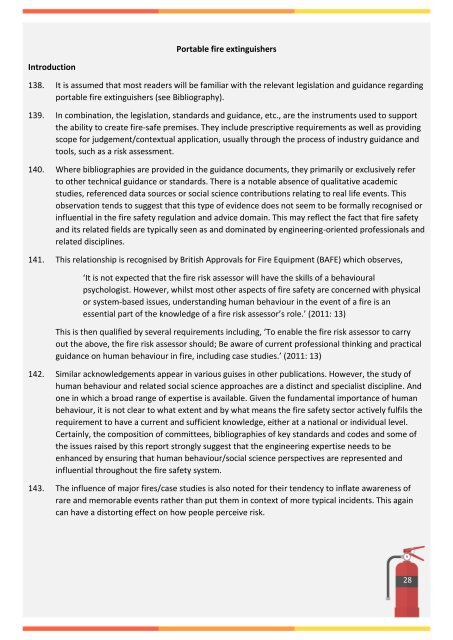An evaluation of the role of fire extinguishers
A report considering the role of a fire extinguisher in human terms identifying the gap between policy assumptions and the evidence from real fires. It considers the implications arising from this and makes a number of recommendations to create an evidence base and enhance current fire safety policies/advice.
A report considering the role of a fire extinguisher in human terms identifying the gap between policy assumptions and the evidence from real fires. It considers the implications arising from this and makes a number of recommendations to create an evidence base and enhance current fire safety policies/advice.
Create successful ePaper yourself
Turn your PDF publications into a flip-book with our unique Google optimized e-Paper software.
Portable <strong>fire</strong> <strong>extinguishers</strong><br />
Introduction<br />
138. It is assumed that most readers will be familiar with <strong>the</strong> relevant legislation and guidance regarding<br />
portable <strong>fire</strong> <strong>extinguishers</strong> (see Bibliography).<br />
139. In combination, <strong>the</strong> legislation, standards and guidance, etc., are <strong>the</strong> instruments used to support<br />
<strong>the</strong> ability to create <strong>fire</strong>-safe premises. They include prescriptive requirements as well as providing<br />
scope for judgement/contextual application, usually through <strong>the</strong> process <strong>of</strong> industry guidance and<br />
tools, such as a risk assessment.<br />
140. Where bibliographies are provided in <strong>the</strong> guidance documents, <strong>the</strong>y primarily or exclusively refer<br />
to o<strong>the</strong>r technical guidance or standards. There is a notable absence <strong>of</strong> qualitative academic<br />
studies, referenced data sources or social science contributions relating to real life events. This<br />
observation tends to suggest that this type <strong>of</strong> evidence does not seem to be formally recognised or<br />
influential in <strong>the</strong> <strong>fire</strong> safety regulation and advice domain. This may reflect <strong>the</strong> fact that <strong>fire</strong> safety<br />
and its related fields are typically seen as and dominated by engineering-oriented pr<strong>of</strong>essionals and<br />
related disciplines.<br />
141. This relationship is recognised by British Approvals for Fire Equipment (BAFE) which observes,<br />
‘It is not expected that <strong>the</strong> <strong>fire</strong> risk assessor will have <strong>the</strong> skills <strong>of</strong> a behavioural<br />
psychologist. However, whilst most o<strong>the</strong>r aspects <strong>of</strong> <strong>fire</strong> safety are concerned with physical<br />
or system-based issues, understanding human behaviour in <strong>the</strong> event <strong>of</strong> a <strong>fire</strong> is an<br />
essential part <strong>of</strong> <strong>the</strong> knowledge <strong>of</strong> a <strong>fire</strong> risk assessor’s <strong>role</strong>.’ (2011: 13)<br />
This is <strong>the</strong>n qualified by several requirements including, ‘To enable <strong>the</strong> <strong>fire</strong> risk assessor to carry<br />
out <strong>the</strong> above, <strong>the</strong> <strong>fire</strong> risk assessor should; Be aware <strong>of</strong> current pr<strong>of</strong>essional thinking and practical<br />
guidance on human behaviour in <strong>fire</strong>, including case studies.’ (2011: 13)<br />
142. Similar acknowledgements appear in various guises in o<strong>the</strong>r publications. However, <strong>the</strong> study <strong>of</strong><br />
human behaviour and related social science approaches are a distinct and specialist discipline. <strong>An</strong>d<br />
one in which a broad range <strong>of</strong> expertise is available. Given <strong>the</strong> fundamental importance <strong>of</strong> human<br />
behaviour, it is not clear to what extent and by what means <strong>the</strong> <strong>fire</strong> safety sector actively fulfils <strong>the</strong><br />
requirement to have a current and sufficient knowledge, ei<strong>the</strong>r at a national or individual level.<br />
Certainly, <strong>the</strong> composition <strong>of</strong> committees, bibliographies <strong>of</strong> key standards and codes and some <strong>of</strong><br />
<strong>the</strong> issues raised by this report strongly suggest that <strong>the</strong> engineering expertise needs to be<br />
enhanced by ensuring that human behaviour/social science perspectives are represented and<br />
influential throughout <strong>the</strong> <strong>fire</strong> safety system.<br />
143. The influence <strong>of</strong> major <strong>fire</strong>s/case studies is also noted for <strong>the</strong>ir tendency to inflate awareness <strong>of</strong><br />
rare and memorable events ra<strong>the</strong>r than put <strong>the</strong>m in context <strong>of</strong> more typical incidents. This again<br />
can have a distorting effect on how people perceive risk.<br />
28<br />
6




